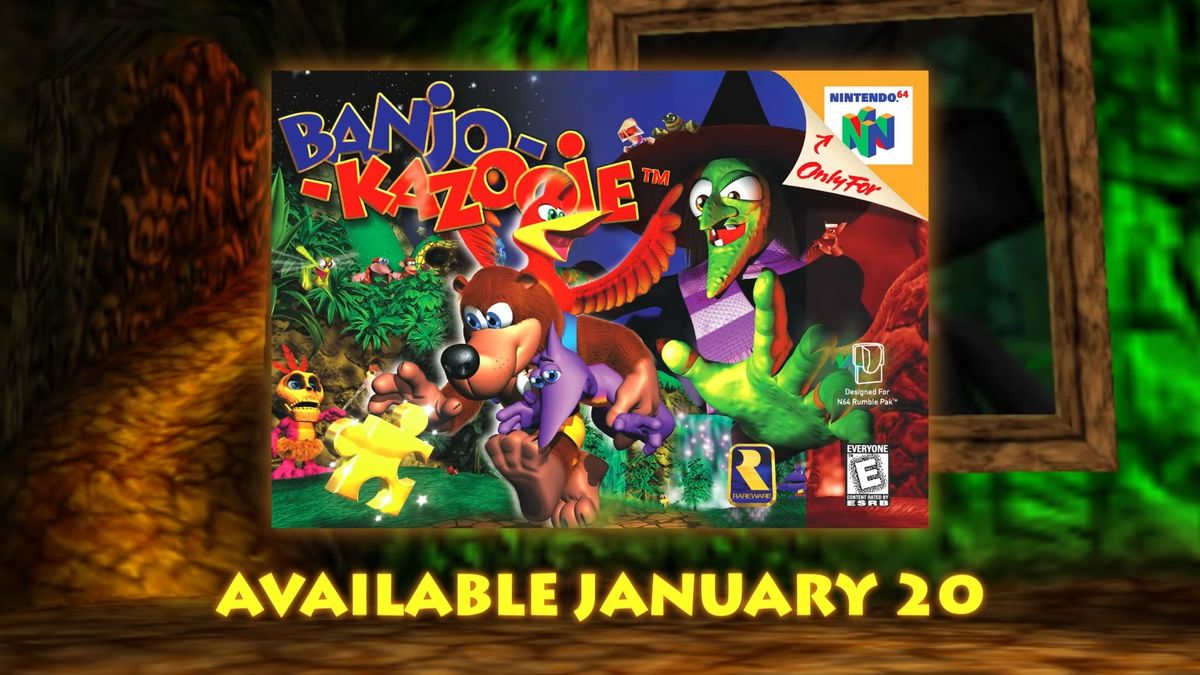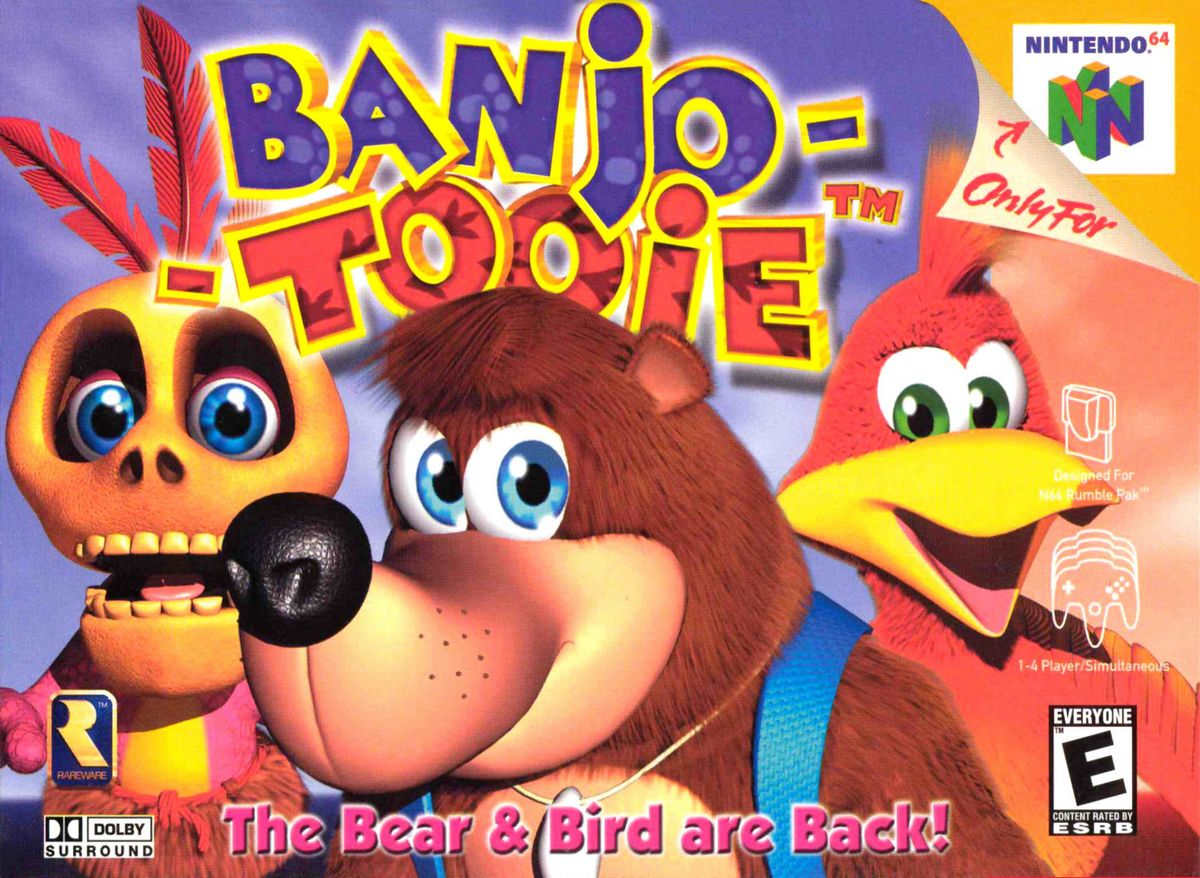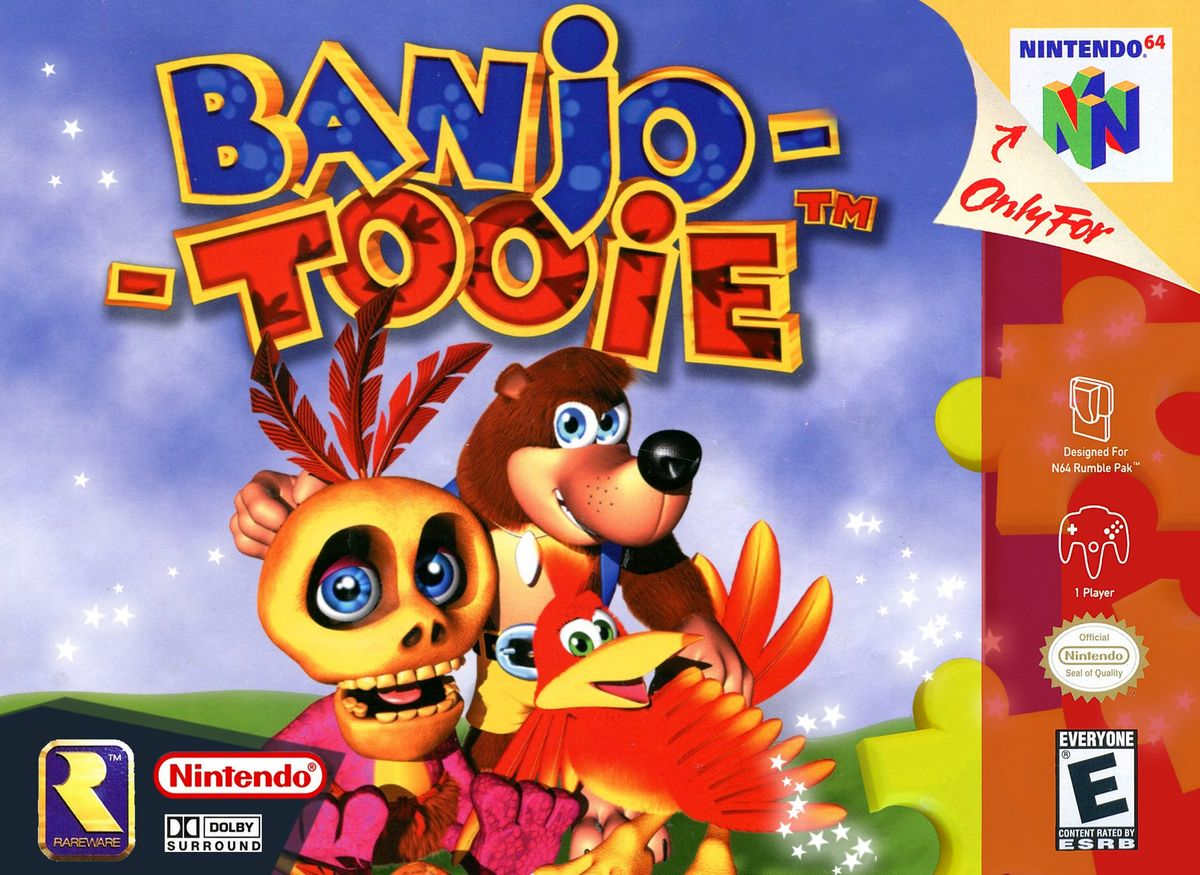Banjo-Tooie is a video game that was released in 2000 for the Nintendo 64 console. Developed by Rare and published by Nintendo, this game is a direct sequel to Banjo-Kazooie, another critically acclaimed platformer title from the same developers. Banjo-Tooie continues where its predecessor left off, following the adventures of Banjo and Kazooie as they explore new worlds, defeat various enemies, and collect valuable items along the way.
This sequel introduces several new features to the gameplay mechanics of its predecessor. One notable addition is the ability to split up Banjo and Kazooie into separate characters, allowing players to control them independently or cooperate with each other in solving puzzles. Furthermore, each character gains unique abilities that enable them to access previously inaccessible areas within levels.
The plot of Banjo-Tooie revolves around Gruntilda’s plan for revenge against our heroes after her defeat in Banjo-Kazooie. She has enlisted her two sisters and created an enormous machine called Hag 1 which she intends on using to destroy everything in sight. It’s now up to our protagonists – with help from some returning characters such as Mumbo Jumbo -to stop Gruntilda once again before it’s too late for everyone involved.
In this article we will delve deeper into what makes Banjo-Tooie one of the most beloved games on Nintento64 consoles not just because it’s a sequel but also because it has introduced so many innovative elements making it stand out among other titles during its launch year..
- The History of Banjo-Tooie: From Development to Release
- Analyzing the Gameplay Mechanics and Features of Banjo-Tooie
- A Look at the Soundtrack and Audio Design in Banjo-Tooie
- How Banjo-Tooie Revolutionized 3D Platformers on Consoles
- Exploring the Worlds and Environments of Banjo-Tooie in Detail
- Examining the Boss Fights and Challenges Presented in Banjo-Tooie
- Comparing the Successes (and Failures) of Banjo-Kazooie vs. Banjo-Tooie
- Assessing Whether or Not a Remastered Version of Banjo-Tooie Could Work Today
The History of Banjo-Tooie: From Development to Release
It is the second installment in the Banjo-Kazooie series and was developed by Rare, one of the most prominent video game developers during its time. The development of Banjo-Tooie began shortly after the release of its predecessor, Banjo-Kazooie.
The team at Rare wanted to expand on and improve upon what they had accomplished with Banjo-Kazooie. They aimed to create a bigger world with more complex puzzles and gameplay mechanics while retaining the charm and sense of humor that made its predecessor so popular among gamers. This led to over two years of intense development work, including extensive testing and reworking various aspects of the game.
One notable aspect of Banjo-Tooie’s development is that it featured an improved graphics engine that allowed for smoother animations and better textures than those seen in previous games from Rare. Additionally, this game introduced new playable characters like Mumbo Jumbo who could transform into various creatures to access different areas as well as Kazooie’s brother named Jamjars who taught new moves to enhance abilities in-game play.

Overall, Banjo-Tooie represents a significant step forward for both Rare and gaming history through its technical advancements and expanded gameplay mechanics which contributed significantly towards establishing it as another iconic classic title from one golden era period when amazing games were born out every year.
Analyzing the Gameplay Mechanics and Features of Banjo-Tooie
The game is a follow-up to the popular Banjo-Kazooie and features similar gameplay mechanics while introducing new features to the series. In Banjo-Tooie, players control Banjo, a bear, and Kazooie, a bird, as they traverse various levels in search of Jiggies – puzzle pieces needed to unlock further areas of the game.
One key feature of Banjo-Tooie’s gameplay is its interconnected levels. Players can use special moves acquired throughout the game to access previously inaccessible areas within each level or even travel between levels altogether. This creates a sense of exploration and discovery as players are encouraged to revisit previous locations with newfound abilities.
Another unique aspect of Banjo-Tooie’s gameplay mechanics is its implementation of cooperative multiplayer mode. In this mode, two players control both characters simultaneously using split-screen graphics. The duo must work together to solve puzzles and defeat enemies which requires careful communication and teamwork.
Furthermore, the game includes various mini-games such as “Jinjo Racing,” where players compete against each other in kart-style races or shooting galleries where they earn points by hitting targets with eggs fired from Kazooie’s mouth at different distances. These mini-games provide some variety within the main campaign while also serving as an opportunity for additional challenges outside it.
Overall, analyzing these varied gameplay mechanics demonstrates why Banjo-Tooie has continued its lasting legacy among gamers everywhere long after it first release nearly twenty years ago despite newer games being available today – something worth noting for any fan interested in diving deeper into what makes classic video games stand out!
A Look at the Soundtrack and Audio Design in Banjo-Tooie
One of the most notable aspects of this game is its impressive soundtrack and audio design, which help to create an immersive gaming experience for players.
The soundtrack features a blend of various musical genres, including orchestral pieces, rock music, and even jazzy tunes. The music feels perfectly integrated into each level or encounter in the game. It enhances player engagement by adding drama and excitement to significant events such as boss fights while providing calming background notes during exploration sequences.
The audio design also plays an essential role in creating an immersive atmosphere throughout Banjo-Tooie. Each sound effect feels well-thought-out with careful attention paid to every detail from enemy noises to environmental sounds like water dripping or wind blowing through valleys. These details come together seamlessly, making the environment feel more realistic than ever before.
Overall, Banjo-Tooie’s excellent soundtrack and audio design give it an edge over other games in its genre. They are not only entertaining but provide emotional depth that resonates with players long after they have finished playing the game. They serve as perfect examples of how effective sound can be at enhancing video games’ overall quality while immersing players deeper into their worlds!
How Banjo-Tooie Revolutionized 3D Platformers on Consoles
The game was developed by Rare and released for the Nintendo 64 in 2000. It built upon the success of its predecessor, Banjo-Kazooie, and took everything to new heights.
One of the most impressive aspects of Banjo-Tooie was its level design. Each world felt like a living, breathing environment with unique challenges and puzzles to solve. The levels were interconnected, allowing players to explore them in any order they wanted, creating a sense of freedom rarely seen before in 3D platformers.
The game also introduced new gameplay mechanics such as split-up pads which allowed players to separate Banjo and Kazooie into two different characters with their own abilities. This added another layer of complexity to solving puzzles and navigating through levels.
Additionally, Banjo-Tooie featured impressive graphics that pushed the limits of what was possible on the Nintendo 64 hardware at the time. The attention to detail in each level was remarkable; from environmental effects like water reflections or lava flows, down to small details such as footprints left behind by characters.
Overall, Banjo-Tooie’s influence on video games cannot be overstated. It set a high bar for future games within its genre and demonstrated how creativity can push technological limitations beyond expectation.
Exploring the Worlds and Environments of Banjo-Tooie in Detail

The game features an expansive world, full of diverse and unique environments to explore. In Banjo-Tooie, players take control of Banjo and Kazooie as they venture through various worlds in order to stop the evil witch Gruntilda from carrying out her nefarious plans.
One of the most notable aspects of Banjo-Tooie’s world design is its diversity. Each environment offers something different, whether it be a prehistoric landscape filled with dinosaurs or a futuristic cityscape brimming with robotic enemies. Players must use their skills and abilities to navigate each world’s challenges and ultimately defeat Gruntilda.
Another key feature of Banjo-Tooie’s levels is their interconnectivity. There are numerous shortcuts between areas that allow players to quickly traverse between previously explored sections. Additionally, many areas can only be fully accessed after acquiring certain abilities or items later in the game.
Overall, exploring the worlds and environments of Banjo-Tooie provides players with hours upon hours of engaging gameplay filled with memorable moments and exciting challenges. Its varied landscapes coupled with clever level design make for an unforgettable gaming experience that stands tall even today among other classic platformers like Super Mario 64 or Sonic Adventure DX: Director’s Cut
Examining the Boss Fights and Challenges Presented in Banjo-Tooie
These encounters require both skillful use of Banjo and Kazooie’s abilities as well as strategic planning to overcome. One such example is the fight against Old King Coal, where players must navigate through a maze-like furnace while avoiding molten hazards and enemies.
Another challenge in Banjo-Tooie is the infamous Canary Mary racing sequence, which requires precise timing and button inputs to win. The reward for winning this challenge is critical progression through the game’s story, making it all the more daunting for players who struggle with racing mechanics.
Lastly, there are several memorable boss fights in Banjo-Tooie that stand out due to their unique mechanics and design. For instance, battling against Mingy Jongo involves using different colored eggs to match his own color-shifting abilities while dodging his attacks. Similarly, Klungo’s battles involve finding weaknesses in his impenetrable armor suit by hitting him at specific times or locations onscreen.
Overall, examining these various boss fights and challenges presented within Banjo-Tooie reveals its depth as a game that requires not only reflexes but also careful thought and experimentation from its players. It offers a uniquely rewarding experience for those willing to take on its many obstacles.
Comparing the Successes (and Failures) of Banjo-Kazooie vs. Banjo-Tooie

While Banjo-Kazooie proved to be a commercial success with its quirky characters, whimsical storyline, and fun gameplay mechanics; Banjo-Tooie faced several challenges in terms of game design and pacing.
Banjo-Kazooie had an innovative approach towards exploration and platforming elements that defined it as a classic among gamers. The game’s colorful world-building was complemented by memorable character designs like Gruntilda, Mumbo Jumbo, Kazooie, Tooty and Bottles – which added depth to its narrative. In contrast, Banjo-Tooie felt more complex due to its non-linear level structure which occasionally led players backtracking through areas they had already visited before.
However, where Banjo-Tooie outshone its predecessor was in the implementation of new abilities such as transformations for both protagonists – something not seen in Banjo-Kazooie. These additions allowed players access into previously inaccessible parts of levels which gave them a sense of accomplishment while exploring each area’s unique story arc.
Ultimately though despite being less successful than their predecessors (with fewer units sold), both games have received critical acclaim from fans worldwide who consider these titles must-haves for anyone interested in playing N64 classics with lighthearted humor mixed with challenging gameplay mechanics.
Assessing Whether or Not a Remastered Version of Banjo-Tooie Could Work Today
However, with newer consoles pushing the limits of graphics and gameplay innovation, it begs the question: could a remastered version of Banjo-Tooie work today? The answer is yes – but with some major caveats.
Firstly, any remaster would need to preserve the original charm and identity that made Banjo-Tooie so special in the first place. This means retaining its vibrant aesthetic and whimsical humor while also modernizing it enough to meet current industry standards. Additionally, any tweaks or updates should be carefully considered to ensure they don’t disrupt the delicate balance between gameplay mechanics and level design.
Another important factor to consider is accessibility. While many fans may be eagerly awaiting a remastered version of their favorite game, it’s crucial that this new iteration brings something fresh to the table without alienating newcomers who have never played before. As such, revamping elements like tutorials or introducing new modes could make for a more inclusive experience overall.
Ultimately, whether or not a remastered version of Banjo-Tooie can succeed depends on how well its core elements are preserved while also being updated for modern audiences. By striking this balance effectively and offering something innovative yet familiar at the same time, a new take on this classic game could very well find success in today’s gaming landscape.
In conclusion, Banjo-Tooie is a prime example of a sequel done right. Rare managed to take the charming platforming formula from the first game and expand upon it in meaningful ways, creating an experience that feels both familiar and fresh. The addition of new moves, characters, worlds, and challenges makes for a game that will keep players engaged for hours on end.

Furthermore, the attention to detail in Banjo-Tooie is truly impressive. From the intricate level design to the quirky dialogue between characters, every aspect of this game has been crafted with care. Even after all these years, it’s clear that Rare poured their hearts and souls into making this one-of-a-kind adventure.
Overall, Banjo-Tooie is a must-play title for fans of classic 3D platformers or anyone looking for an unforgettable gaming experience. Its timeless gameplay mechanics and whimsical atmosphere make it stand out among other games in its genre even today. Without question, Banjo-Tooie deserves its place in gaming history as one of the greatest sequels ever made.
Read More:- Unleash Your Inner Hero with The Legend of Zelda: A Link Between Worlds Game.
- Discover the Thrilling World of Pokemon Mystery Dungeon: Red Rescue Team Game – Engage in Exciting Adventures!.
- Discover the New World of Xenoblade Chronicles 2: Torna ~ The Golden Country – a Guide to Gameplay and Storytelling!.
- Master the Explosive Action of Bangai-O: The Ultimate Guide to Beating this Classic Game!.
- Embark on Exciting Elebits Adventure with Kai and Zero in this Thrilling Game!.
- Discover the Best Tips and Tricks for Playing Pokemon Platinum Version – Your Ultimate Guide!.
- Discover the Exciting World of Yo-kai Watch 2: Psychic Specters with New Levels & Characters!.